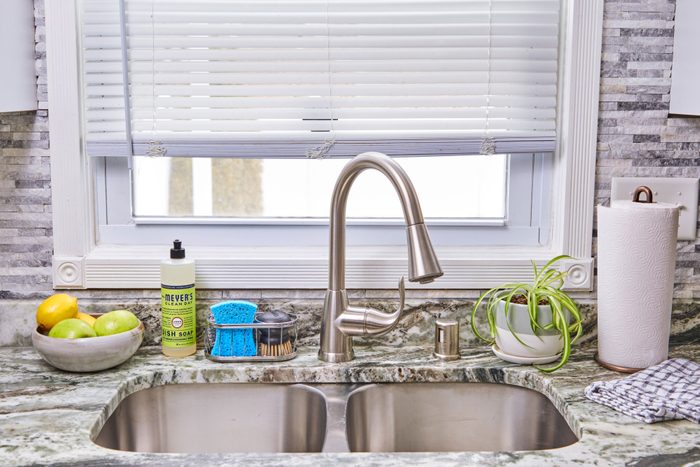
Deep-clean your stainless steel sink
To keep your sink rust-free long term, it’s essential to know how to clean a stainless steel sink properly. “Kitchen sinks are the workhorses of your home,” explains Sara San Angelo, founder of the site Confessions of a Cleaning Lady. “So it’s not surprising that they will get dirty and grimy.” You can tell when a stainless steel sink needs to be cleaned because grease and food particles will start to stick to the basin and contribute to the grimy appearance, she says. From there, rust spots can form, turning your sink a dingy brown.
The good news: Cleaning kitchen appliances regularly will help keep the whole room free of germs and looking brand-new. So don’t be afraid to make a cleaning schedule to remind yourself when to freshen up the stainless steel sink or clean other stainless steel appliances. Having a schedule may guarantee you’ll follow along with all the steps for how to clean your kitchen sink or how to clean kitchen cabinets.
While you’ll want to do a super-quick clean every day with soap, water and a sponge, you’ll still need to do a regular deep-clean to your stainless steel sink. So read on for our expert advice on how to clean your stainless steel sink and give it that deep-clean it needs to stay both hygienic and sparkling.
Get Reader’s Digest’s Read Up newsletter for more cleaning, humor, travel, tech and fun facts all week long.
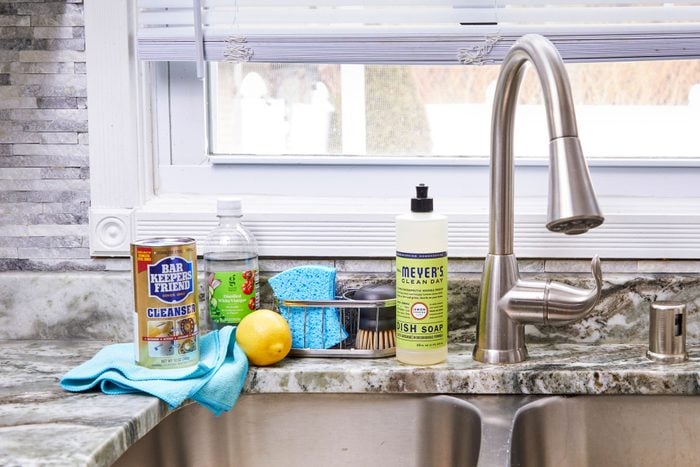
Gather your sink-cleaning supplies
Learning how to clean a stainless steel sink is fairly simple. To get started, you’ll need a few household ingredients that are probably already sitting in your pantry, from sponges to mild dish soap or a mild scrub like Meliora Cleaning Products Gentle Cleaning Scrub.
Things you definitely won’t need? Vinegar, for starters. That’s right: Even though other kitchen-cleaning jobs may require the superpowered combo of baking soda and vinegar, this project relies on baking soda alone. Another kitchen-cleaning mistake? Using bleach on stainless steel.
“You should never use bleach to clean your stainless steel sink,” says San Angelo. “The thing that makes stainless steel ‘stainless’ is a protective layer of chromium oxide. Bleach can eat away at this layer, rendering your sink susceptible to rusting and staining. Also, contrary to popular belief, cleaning your sink with vinegar will do the same thing. So skip the vinegar and bleach when cleaning your stainless steel sink.”
What you’ll need:
- Microfiber cloth
- Mild dish soap, like Mrs. Meyer’s
- Non-scratch cellulose scrub sponges
- Baking soda or Bar Keepers Friend
- One lemon
- White vinegar (for cleaning the drain only)
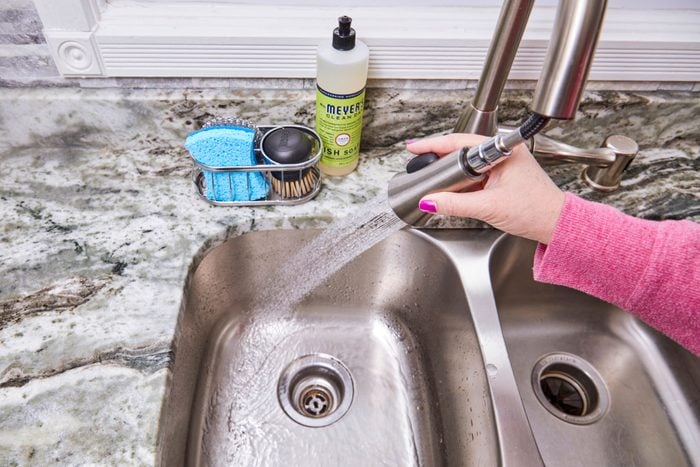
Step 1: Empty and rinse the sink
Don’t dive right into the cleaning supplies! If you want to learn how to clean a sink the right way, start by emptying it. Clean those dirty dishes, remove any rubber mats or metal sink grids and don’t forget the sponge holder. Then rinse the sink thoroughly with hot water, using the faucet sprayer, if you have one.
Pro tip: The main cause of your dirty sink is likely grease and food debris, says San Angelo, so make sure these are washed down entirely. Sweep the sponge across the surface of the sink to make sure everything goes down the drain. Remember to clean your kitchen sponge before using it again.
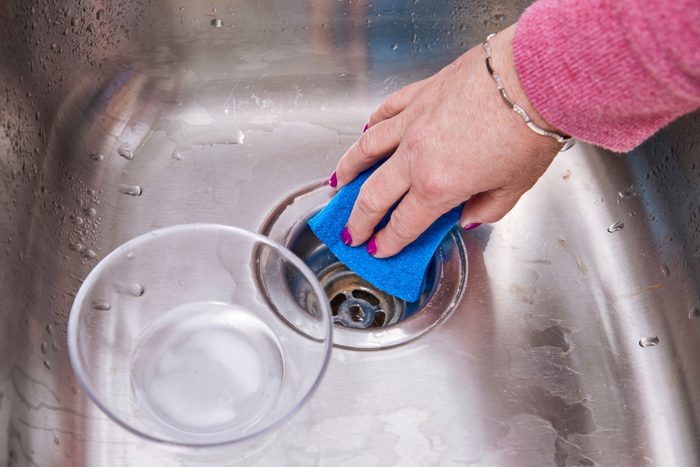
Step 2: Clean the drain
Knowing how to clean a stainless steel sink goes beyond the basin. You’ll need to clean all aspects of the sink, the drain included. So once the sink is cleared, you can do a quick drain cleaning.
To get started, grab a small bowl and add to it 1 tablespoon baking soda, a half cup of water and 1 tablespoon white vinegar. Dip your sponge into the mixture, then use it to scrub the drain hole and remove any stains or buildup. Wait five to 10 minutes, then rinse it down the drain with warm water from your faucet.
Pro tip: Because it contains vinegar—a stainless steel no-no, according to San Angelo—limit where you use this DIY cleaner, confining it to the sink drain and drain hole. A small amount shouldn’t do any harm, but if the mixture comes into contact with the stainless steel, wipe it up with a damp sponge.
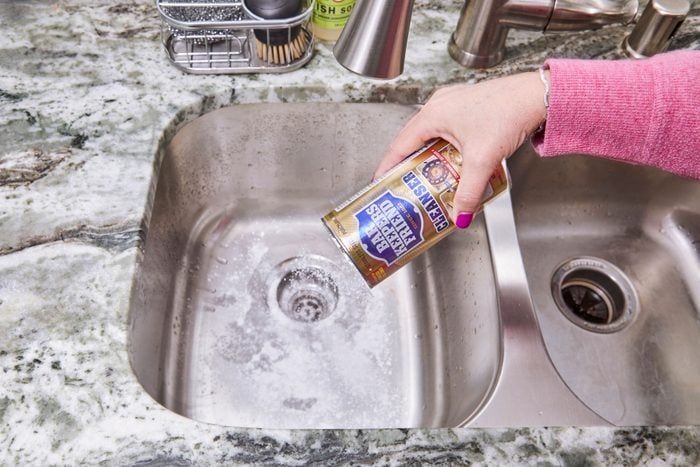
Step 3: Sprinkle cleaning powder
Sprinkle the damp sink with baking soda or Bar Keepers Friend. (That’s right: Not only is baking soda useful in your baked goods, but it’s also a wonder when it comes to cleaning—it’ll freshen up everything from your sink to your shower curtain liner.) Cover the entire surface of the sink with a thin layer, and be sure to include the sides and drain.
Pro tip: Get an above-and-beyond clean by swapping baking soda for Bar Keepers Friend, which comes in powder or liquid form. San Angelo swears by it. “It’s amazing on stainless steel and has garnered a sort of cult following in cleaning circles,” she says. “And it is great for removing rust and hard-water stains from stainless steel sinks.”
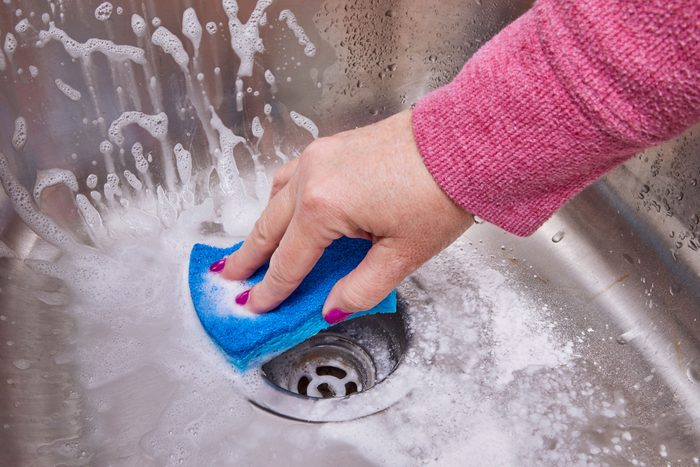
Step 4: Scrub the sink
To clean the sink with baking soda or powdered Bar Keepers Friend, make a paste by mixing the layer of powder with the water left on the surface of the sink. It’s as easy as gently circling a damp sponge around the sink. This will take only a few seconds—you don’t want to scrub until the mixture has been able to sit.
Next, let the mixture sit for 10 to 15 minutes. When time’s up, you can give the basin a deeper cleaning. “Scrub with the sponge gently, as baking soda is abrasive enough to clean grease and hard-water stains, but it’s not so abrasive that it will scratch your sink,” says San Angelo.
Pro tip: Always scrub with the soft side of the sponge, she says. The abrasive side can scratch the sink, and that is not how to clean stainless steel the right way. Want to reduce your chances of making that mistake? Use a sponge like Scrub Daddy that doesn’t have an abrasive side.
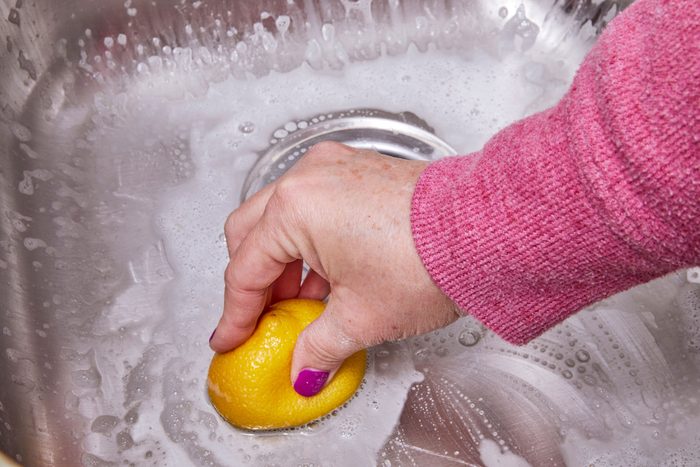
Step 5: Using a lemon, scrub again
Before you rinse the baking soda from your sink, give it an extra dose of cleaning power—and freshness—by cleaning with lemon. Cut a lemon in half, and use the halves to scrub the sink again. Be sure to tackle the sides as well as the bottom. The high acid levels in lemon juice (and lime juice!) can help fight bacteria, not to mention freshen your sink with a lovely citrus smell.
Pro tip: Before scrubbing, remove any seeds from the lemons. Those may scratch the sink.
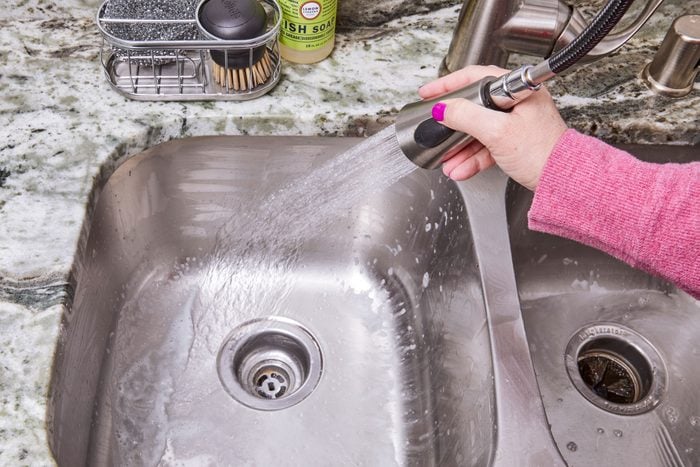
Step 6: Rinse
Rinse away the baking soda paste and lemon juice with water.
Pro tip: Don’t let those lemons go to waste! Chop up one of the lemon halves and run it through the garbage disposal. It’s an easy, all-natural way to clean the garbage disposal and freshen it. But be sure to hold on to at least one lemon half for the next step!
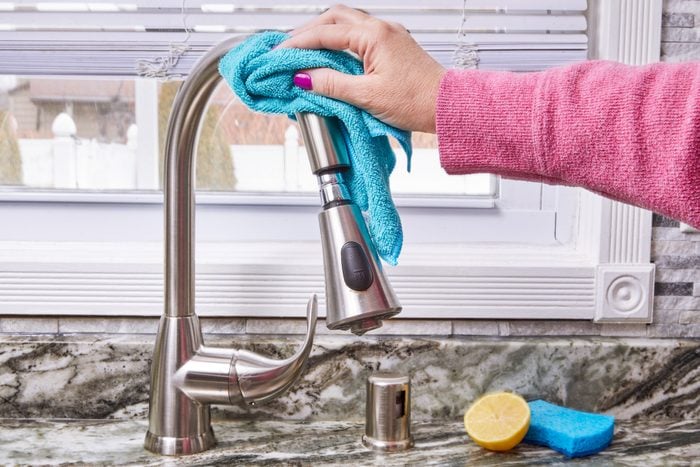
Step 7: Clean the faucet
Remember, learning how to clean a stainless steel sink is about cleaning every last part of the sink, so before you call it a day, turn your attention to the faucet. After the baking soda and lemon juice is rinsed away, use a damp cloth or sponge to wipe down the faucet.
Remember that leftover lemon half? It’s about to give you even more cleaning power. Squeeze any remaining lemon juice onto the damp sponge or cloth. Use it to wipe down the faucet for an extra shine.
Pro tip: For even more natural lemon power, use the fruit to clean your faucet head. Place the halved lemon in a plastic bag with the flesh facing up. Hold the lemon against the faucet head. With a rubber band, tie the plastic bag tightly to the faucet so the lemon remains against the head. Leave it in place for five minutes. Afterward, wipe the faucet with a damp sponge or cloth to remove any remaining lemon juice.
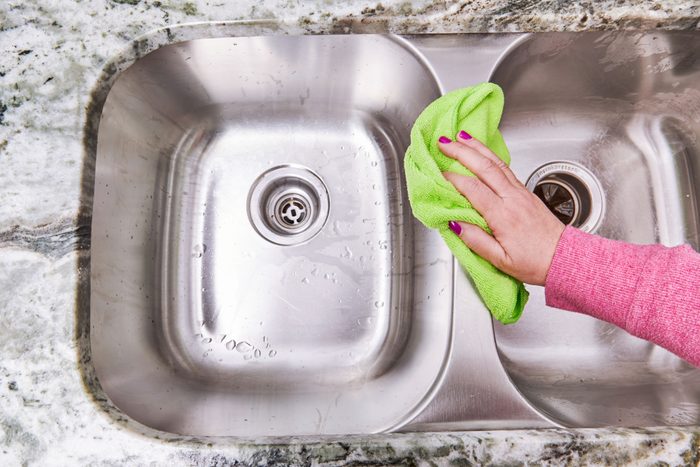
Step 8: Dry and shine
With the microfiber cloth, dry the sink, removing any remaining water and baking soda or Bar Keepers Friend. The microfiber cloth will prevent further rust and hard-water stains, says San Angelo. And that’s how to clean a stainless steel sink!
Pro tip: Use olive oil to really amp up the shine and make your stainless steel sink look like new. Pour a small amount onto a dry cloth and rub it onto the sink, working in the direction of the grain. Wipe off any access oil and admire your hard work.
Source:
- Sara San Angelo, founder of Confessions of a Cleaning Lady
